Chapter 7:
She Sells Sea Shells…
// Jurassic
In Chapter 7, we discover how the geologist and Dean of Westminster, Dr William Buckland investigated stones associated with the abdomens of Ichthyosaur, as found by Mary Anning - the famous fossil-collector of Lyme Regis. Anning had broken open some of these stones and found that some of them contained fossilised fish scales and bones. In 1829, Buckland concluded that they were fossilised faeces and gave them a name - coprolites. Buckland even inlaid a selection of them into an ornate side-table made especially for his home and much admired by many visitors, unaware of its provenance.
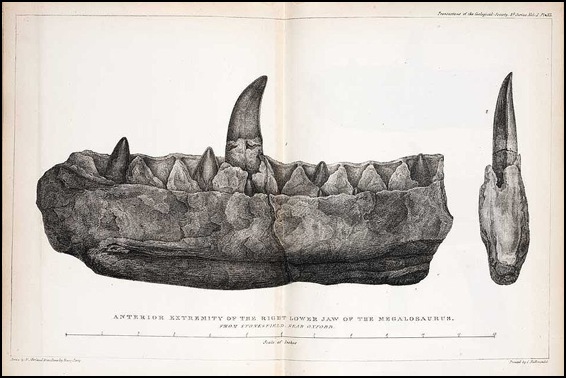
Buckland probably had a great many visitors; aside from his clerical duties, he was a geologist of great skill. Five years before he announced coprolites to the scientific world, he described the first non-avian dinosaur - later named Megalosaurus bucklandii - (above) and discovered the skeleton of what is still the oldest example of homo sapiens (Modern human) to be found in the UK. The 30,000 year old skeleton of the Red Lady of Paviland (actually the ‘lady’ is no such thing, more of a man who died at the approximate age of 21) is also the oldest example of a ceremonial burial in Western Europe.).

Buckland probably had a great many visitors; aside from his clerical duties, he was a geologist of great skill. Five years before he announced coprolites to the scientific world, he described the first non-avian dinosaur - later named Megalosaurus bucklandii - (above) and discovered the skeleton of what is still the oldest example of homo sapiens (Modern human) to be found in the UK. The 30,000 year old skeleton of the Red Lady of Paviland (actually the ‘lady’ is no such thing, more of a man who died at the approximate age of 21) is also the oldest example of a ceremonial burial in Western Europe.).
A more ancient Dorset
// Jurassic
Time to pause and admire some of the beautiful and ornate illustrations inspired by the work of Mary Anning. The first is this illustration of the skeletal anatomy of a Plesiosaurus dolichodeirus from an 1824 paper by William Conybeare that described an almost complete fossilised plesiosaur that was found by Mary Anning in the preceding year.
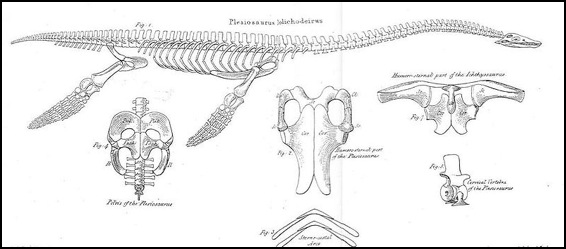
This watercolour (below), painted by the English geologist Henry De la Beche in 1830 was based on the fossils Anning had collected and the complex food chain surmised from the coprolites of ichthyosaurs by Dr William Buckland. It was the first such drawing based on fossil evidence. When Anning faced financial difficulties, De la Beche commissioned a lithographic print of his watercolour, sold copies of it to colleagues and donated all the proceeds to the fossil collector. The original watercolour was called Duria Antiquior - a more ancient Dorset.
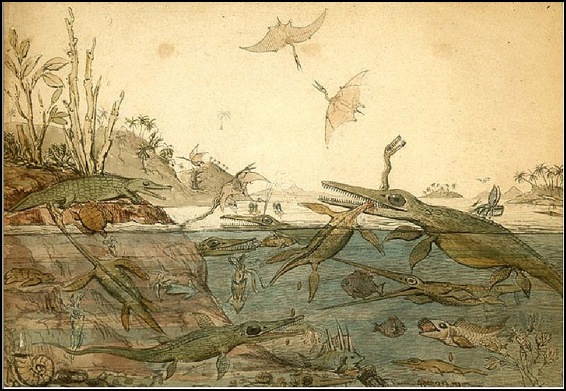
Another scientific description below - this time of Ammonites, but with an artitic twist from Ernst Haeckel’s 1904 book, Kunstformen der Natur (Artforms of Nature) - showing a few varieties of the highly successful family of prehistoric cephalopods. The ammonites were all wiped out 65 million years ago - at the same time as the extinction of the dinosaurs and 70% of all species - when a giant asteroid hit the earth. Biodiversity, however, was already under threat for many millions of years before the strike. Some scientists believe that a period of extreme volcanic activity may have extinguished many species even before the event.
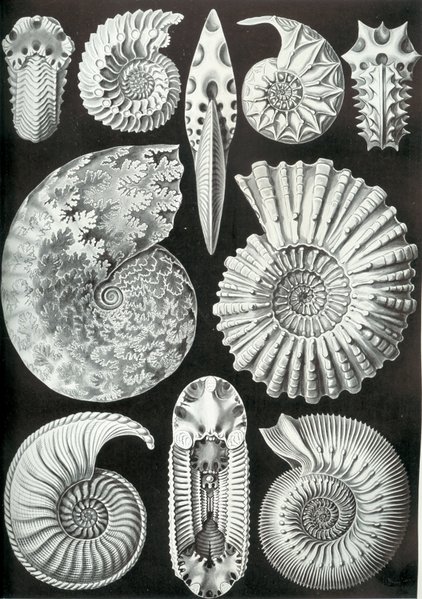
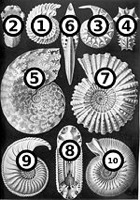
1. Ammonites (Cardioceras) cordatus from the side
2. Ammonites (Cardioceras) cordatus from below
3. Ammonites (Schloenbachia) Coupei from the side
4. Ammonites (Schloenbachia) Coupei from below
5. Ammonites (Ptychites) opulentus from the side (outer shell layer removed)
6. Ammonites (Ptychites) opulentus from below
7. Ammonites (ornatus) mammillaris from the side
8. Ammonites (planulatus) cavernosus cross-section
9. Ammonites (amaltheus) rotula from the side
10. Ammonites (stephanoceras) Humphryi from the side
All images in public domain. Sourced from Wikimedia.

This watercolour (below), painted by the English geologist Henry De la Beche in 1830 was based on the fossils Anning had collected and the complex food chain surmised from the coprolites of ichthyosaurs by Dr William Buckland. It was the first such drawing based on fossil evidence. When Anning faced financial difficulties, De la Beche commissioned a lithographic print of his watercolour, sold copies of it to colleagues and donated all the proceeds to the fossil collector. The original watercolour was called Duria Antiquior - a more ancient Dorset.

Another scientific description below - this time of Ammonites, but with an artitic twist from Ernst Haeckel’s 1904 book, Kunstformen der Natur (Artforms of Nature) - showing a few varieties of the highly successful family of prehistoric cephalopods. The ammonites were all wiped out 65 million years ago - at the same time as the extinction of the dinosaurs and 70% of all species - when a giant asteroid hit the earth. Biodiversity, however, was already under threat for many millions of years before the strike. Some scientists believe that a period of extreme volcanic activity may have extinguished many species even before the event.


1. Ammonites (Cardioceras) cordatus from the side
2. Ammonites (Cardioceras) cordatus from below
3. Ammonites (Schloenbachia) Coupei from the side
4. Ammonites (Schloenbachia) Coupei from below
5. Ammonites (Ptychites) opulentus from the side (outer shell layer removed)
6. Ammonites (Ptychites) opulentus from below
7. Ammonites (ornatus) mammillaris from the side
8. Ammonites (planulatus) cavernosus cross-section
9. Ammonites (amaltheus) rotula from the side
10. Ammonites (stephanoceras) Humphryi from the side
All images in public domain. Sourced from Wikimedia.
The view from Lyme Regis
// Jurassic
Of all the places to look for ammonites in Lyme Regis, apart from the gift shops, Monmouth Beach is the easiest. They are littered around almost everywhere, but you can’t take the big ones home or hammer away at them. The one below was about the size of a bagel, attached, with others, to a rock about the size of a Ford Fiesta.
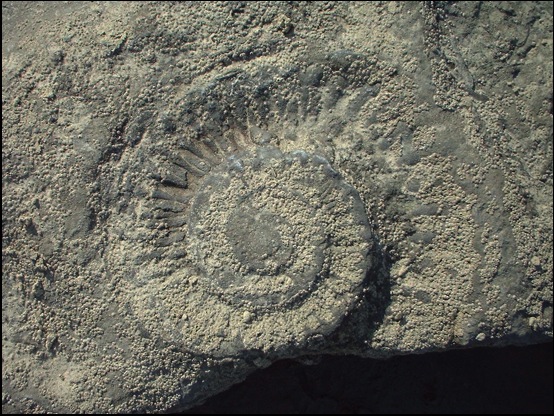
(Below) Golden Cap - at 626 feet, the highest point on the English south coast - as seen from Lyme’s eastern ‘beach’ the Broad Ledge - also good for spotting Ammonites up to 3 feet across.
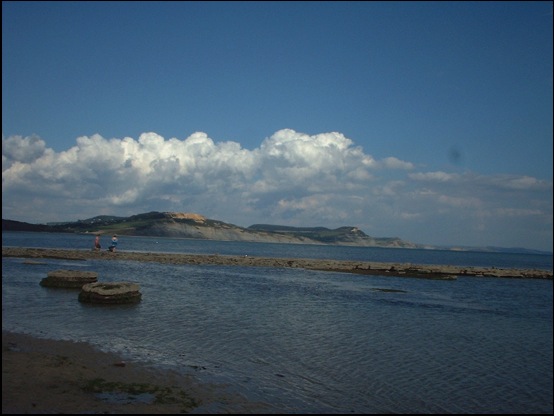
Here’s a view looking the same way, but from Charmouth - a few miles east along the coast. The golden cap of rocks - called, with refreshing simplicity, Golden Cap - forms the highest cliffs on the south coast. Note the hoards of people walking the beach in search of fossils.
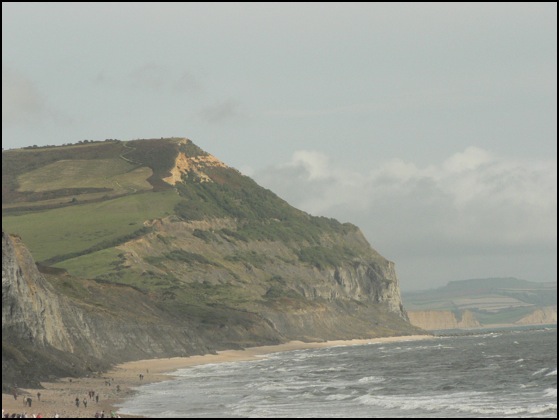
From the same spot on the cliffs at Charmouth you can look back towards Lyme Regis. This picture was taken on a bright autumn day, with a dramatic looking storm heading in from the north west.
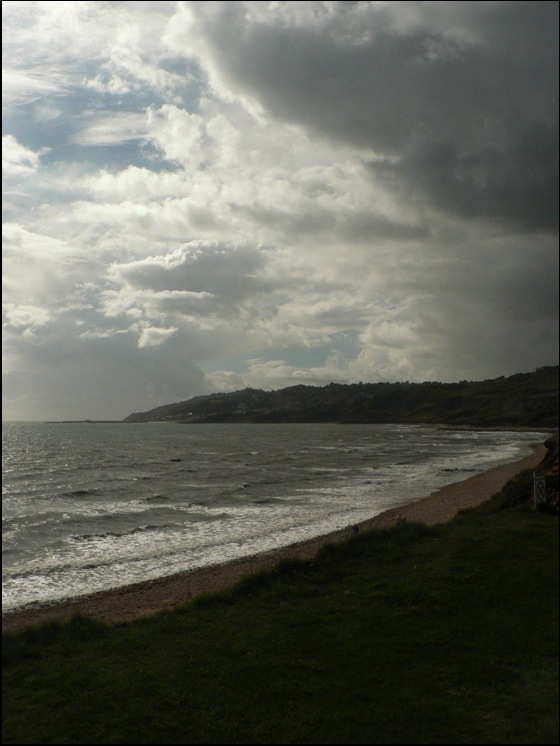

(Below) Golden Cap - at 626 feet, the highest point on the English south coast - as seen from Lyme’s eastern ‘beach’ the Broad Ledge - also good for spotting Ammonites up to 3 feet across.

Here’s a view looking the same way, but from Charmouth - a few miles east along the coast. The golden cap of rocks - called, with refreshing simplicity, Golden Cap - forms the highest cliffs on the south coast. Note the hoards of people walking the beach in search of fossils.

From the same spot on the cliffs at Charmouth you can look back towards Lyme Regis. This picture was taken on a bright autumn day, with a dramatic looking storm heading in from the north west.

